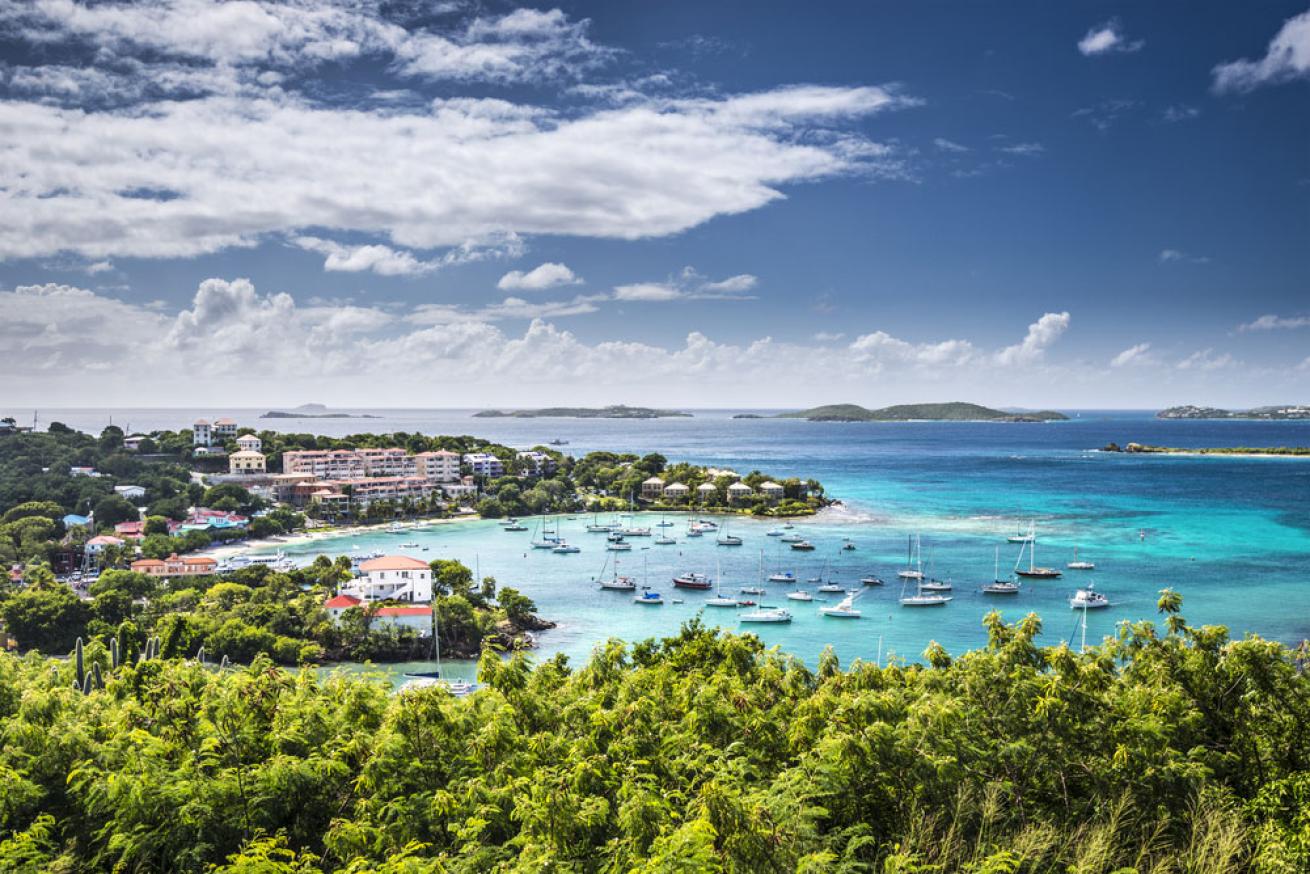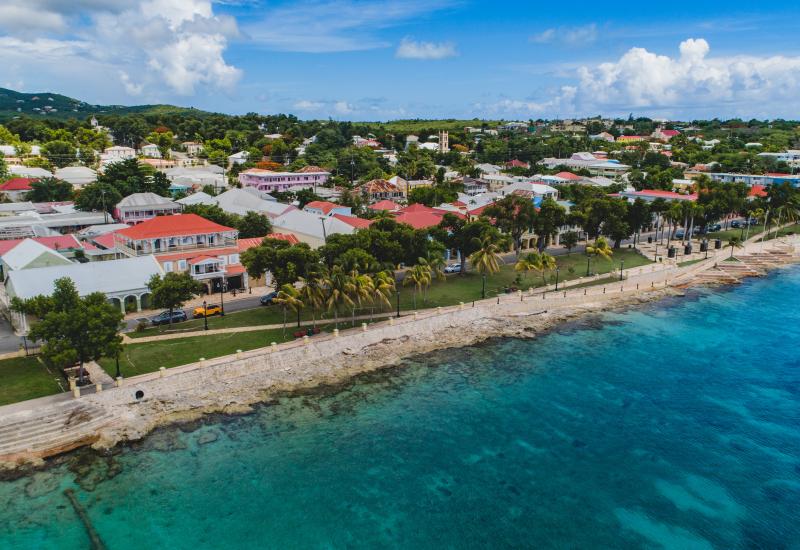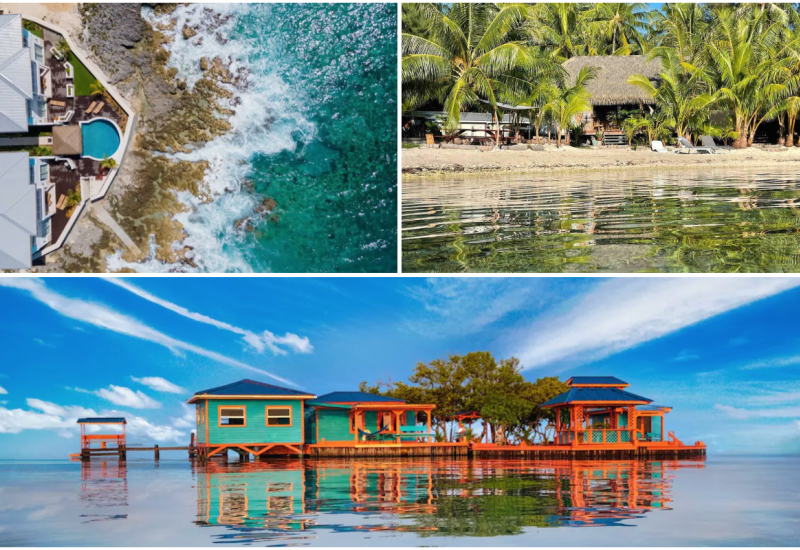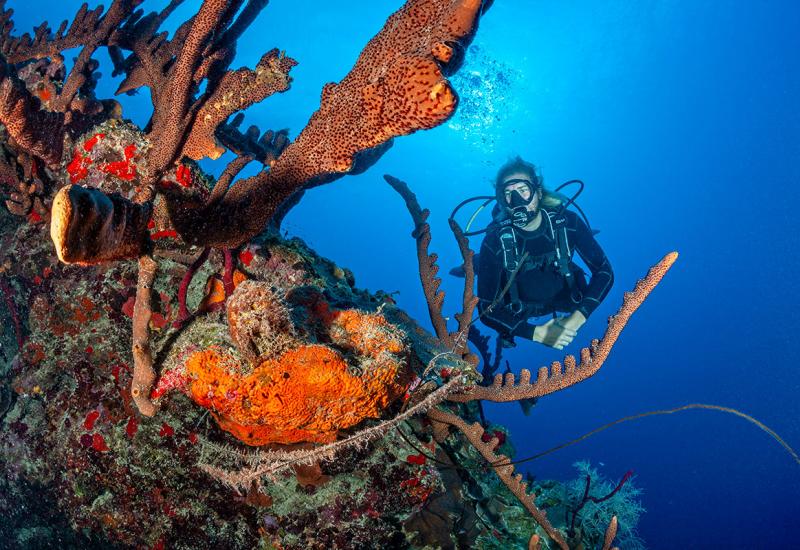U.S. Virgin Islands: Lessons In Downtime

Cruz Bay, St John, United States Virgin Islands
When I lived on St. Thomas in the late 1990s, diving was my mistress. I'd moved down to the U.S. Virgin Islands ostensibly to work evenings for the local newspaper. But the sea had an equal claim on my time, and I was soon "daylighting" as a divemaster, leading tours of the reefs and wrecks. The islands — St. Thomas, St. John and St. Croix — enchanted me, and the more I explored the more I found to love.
The trio of islands routinely lands on popular lists of top dive destinations, including Scuba Diving's Top 100 Readers Choice survey — and for good reason. Water temps straddle either side of 80 degrees, and while the surface spans a palette of blue-greens, diving beneath is like flight itself, with visibility often exceeding 100 feet. Most sites off St. Thomas and St. John lie within 20 minutes of the dock and in less than 70 feet of water. And when you're ready for the deep end, St. Croix offers world-class wall diving.
Island by island, here are my picks for the very best dives, topside attractions and places to lime (you know, hang out).
St. Thomas
Better known as a bustling cruise ship port-of-call, duty-free shopping haven and a raucous Carnival hot spot, St. Thomas is often overlooked as a dive destination — and that's a mistake. Diverse sites span the south shore, ranging from shallow reefs riddled with swim-throughs to scattered wrecks with interesting stories. Several dozen popular sites ring Pillsbury Sound, which separates St. Thomas and St. John. These sister islands straddle the shallow Virgin Bank, a sandy ocean shelf that limits maximum depths to an easy 70 feet. Most sites lie within 20 minutes of the dock. Given the right conditions, dive operators offer special advanced trips to exposed rock pinnacles off the south shore.
Best Dives
Dave's Favorite: Cartanza Señora
Depth: 20 to 60 feet
Skill Level: Novice
When first sunk as an artificial reef in 1979, the intact 190-foot freighter was a thrilling sight. In the mid-1990s, however, back-to-back hurricanes broke the ship into three sections, making it a very different dive. It was Bill Letts, my former captain at St. Thomas Diving Club, who taught me to see beyond the battered pieces of steel and appreciate it as a haven for smaller marine life. I spent hours taking it all in: nervous sergeant majors standing sentry over egg masses that paint the hull lavender; blennies with old men's faces popping from tiny wormholes, giving the stink eye to passing divers; yellowhead jawfish rising genie-like from their sandy burrows. In March 2005, Bill passed away in his sleep after a banner three-dive day. Honoring his wishes, fellow divers sprinkled his ashes amid the wreck, there to rest with his chosen love.
Miss Opportunity
Depth: 55 to 90 feet
Skill Level: Intermediate
Scuttled two decades ago as an artificial reef, this 300-foot-plus WWII hospital barge lies upside down on the sand, offering a Looking Glass dive, with an operating table on the ceiling and light fixtures beneath your fins. Windows and hatches let in lots of natural light to the ship's interior, but pay close attention to avoid stirring up silt or getting entangled.
WIT Shoal II
Depth: 30 to 90 feet
Skill Level: Intermediate
Upright and still remarkably intact, this former tank landing ship (LST 467) is a must-see dive. The vessel saw service in the Pacific before working as an interisland freighter. She was sunk in 1985 as an artificial reef and sports a mature, dense layer of encrusting growth and abundant marine life. Bright cup corals and sponges coat the once battleship-gray hull, while resident barracuda prowl the wreck fore and aft. Trivia: The wreck is often misidentified as its sister wreck, the WIT Shoal, which lies outside the Panama Canal.
Frenchman's Cap (Frenchcap Cay)
Depth: 35 to 95 feet
Skill Level: Advanced
This remote offshore islet, a 30-minute boat ride south of St. Thomas, is diveable only in flat-calm conditions. If you have the time, it's worth the effort, with hordes of fish crowding three distinct attractions — The Cathedral, a shallow sunlit chamber at 35 feet; the Ledges, a series of lobster-stuffed undercuts that drop down to 65 feet; and my favorite, the Pinnacles, a series of current-swept spires that rise from 95 feet, and are usually crowded by schools of jacks and barracuda.
Cow & Calf
Depth: 45 feet
Skill Level: Novice
Named for the islands' whaling past, these rocks in 45 feet of water are child's play in the best sense, with caves, ledges and colorful swim-throughs, including the whimsical "Champagne Cork" where the surge expels divers from the interior reef in a shower of bubbles. Your guides for the trip include plenty of colorful reef fish, including damselfish, blue tangs, angelfish, grunts and parrotfish.
Sail Rock
Depth: 90 feet
Skill Level: Advanced
Legend has it that a nearsighted captain once fired on this triangular rock formation after mistaking it for a hostile warship, hence the name. Lying 10 miles south of St. Thomas Harbor, the isolated pinnacle attracts schooling horse-eye jacks, hawksbill turtles and curious sharks. With intense currents and a max depth of 90 feet, it's an advanced dive to be sure, but well worth it.
St. John
An easy, chatty 20-minute ferry ride across Pillsbury Sound from St. Thomas, St. John shelters about half of the Virgins' hundred beaches and offers a wholly different Caribbean vibe. Three-fifths of the island is protected within the Virgin Islands National Park. Two main settlements bookend the island: Cruz Bay to the west and Coral Bay out east, each with an eclectic mix of shops, restaurants, bars and dive centers. Cruz Bay dive shops access many of the same sites reachable from St. Thomas, including the fringing reefs off Thatch, Grass, Mingo, Lovango and Congo Cays. Farthest east, Carval Rock offers a busy wall dive. From Coral Bay, you can visit Eagle Shoal, which features a mystical cave laced with swim-throughs.
Best Dives
Dave's Favorite: Eagle Shoal
Depth: 50 feet
Skill Level: Intermediate
When conditions allow, I head straight to this seldom-visited maze of canyons and swim-throughs. At the heart of the shoal is a sun-dappled cave known as The Cathedral where you can kneel on the sand at 40 feet and admire a glowing fresco of orange cup corals, fiery sponges and soft emerald algae. A Seussian chandelier of tube sponges hangs from the ceiling, while a curtain of shimmering silversides often fills the overhead skylight. Lone barracudas keep silent watch at the doors.
Major General Rogers
Depth: 40 to 65 feet
Skill Level: Intermediate
This 135-foot former Coast Guard buoy tender sits upright on the sand at 65 feet midway between St. Thomas and Thatch Cay. Start at the photogenic propeller and work your way along the hull, coated in sponges and cup corals.
Mounds at Mingo
Depth: 15 to 50 feet
Skill Level: Novice
This easy, pretty site presents a marine version of hill country, with a series of low-profile mounds on a sandy bottom at 50 feet. Rich coral and sponge life attracts a range of tropicals and passing rays. Juveniles shelter amid star corals in the shallows.
Carval Rock
Depth: 20 to 80 feet
Skill Level: Advanced
Carval offers the only true wall dive outside of St. Croix, with a sheer north face that drops to 80 feet. Explore the narrow cuts and swim-throughs, but keep an eye on the blue for tarpon and pelagics, which gather to feed on frenetic shoals of silversides. Located east of Congo Cay, the dramatic rock formation attracts a range of creatures — turtles, tarpon, eels, lobsters, nurse sharks — and features a lush coral forest. Currents can be tricky, making it an advanced dive.
Witch's Hat
Depth: 30 feet
Skill Level: Novice
Named for a distinctive rock that stabs the surface, this site outside Cruz Bay centers on a crescent of ledges capped with current-swept sea rods and plumes. Orange cup corals and elephant ear sponges light up the undersides and support dozens of fish species.
St. Croix
If St. Thomas is the party girl and St. John the earth girl, St. Croix is their shy southern sister, content with slow life in the countryside, but concealing a flicker of withheld secrets along her north shore. The island lies 40 miles south of her siblings--just visible on a clear day — and can be reached via seaplane. Modern-day St. Croix struggles with a split personality: Sheep and cattle still roam the mostly rural countryside, but the airport and a massive oil refinery dominate the south side of the island. Thus diving is limited to the west end — home to several shipwrecks and the magical Frederiksted Pier —and the north shore. Just outside Christiansted Harbor is Long Reef, a three-mile spur-and-groove system with several perfectly good sites. But most divers fixate on the wall, which stretches farther west and plunges two miles into the Virgin Trough.
Best Dives
Dave's Favorite: Vertigo
Depth: 50 to 130-plus feet
Skill Level: Advanced
Vertigo is the westernmost site on the St. Croix wall and holds a special place in my logbook as the spookiest dive I've ever made. The dive starts in a bright, white-sand bowl that spills over the wall's edge at 85 feet and the effect is like falling through a trap door. Your stomach falls into your fins at the sight below. Inky nothingness. The wall beneath the ledge folds in on itself, leaving you suddenly suspended over a hundred-fathom void with no reference point. The wall face is covered with busy black coral trees, and the depths are home to passing schools of jacks and snappers and the occasional shark.
Butler Bay Wrecks
Depth: 20 to 110 feet
Skill Level: Intermediate
Six wrecks — yes, six! — comprise two distinct dives: The 177-foot freighter Rosaomaira and 83-foot tug Coakley Bay are within sight of each other at 80 to 110 feet deep, while three other ships and the underwater habitat Aegir lie between 45 and 85 feet deep.
Salt River Canyon
Depth: 30 to 130-plus feet
Skill Level: Intermediate
This canyon splits the north shore wall, leaving two buttresses marked by a florid jumble of pinnacles, swim-throughs, overhangs and drop-offs. While there are no guarantees, divers here have a chance of encountering spotted dolphins and hammerhead sharks.
Pinnacle
Depth: 55 to 130-plus feet
Skill Level: Advanced
Also known as Seamount or Jimmy's Surprise, this deep-water pinnacle on the north shore wall rises from 90 to 30 feet. Massive barrel and orange elephant ear sponges cap the mount, while reddish-brown deep-water sea fans shroud its base like a winter forest.
Cane Bay
Depth: 25 to 130-plus feet
Skill Level: Intermediate
It's a hundred-yard paddle from the beach at Cane Bay to the best-known stretch of wall, where deep grooves funnel sand into the deep. Along the way, you'll pass house-size coral heads. To the east at 80 feet are three anchors in a wide V-shaped chute; search here for seahorses.
InDepth
Water Conditions: Water temperatures range from the upper 70s in winter to the mid-80s in summer. Visibility ranges from 50 to 100 feet.
Weather: Air temps range from the low to high 80s year-round.
Money Matters: The official currency is the U.S. dollar. Most credit cards are accepted, and traveler's checks are widely accepted in hotels, shops and restaurants as long as they are in U.S. dollars.
Documents: U.S. citizens do not need a passport.
Language: English.
Time: Atlantic Standard, one hour ahead of Eastern Standard.
Electricity: 110 volts.
Local Area Code: 340.
Just In Case: There is a recompression chamber on St. Thomas.
For More Info: U.S. Virgin Islands Tourism.

Cruz Bay, St John, United States Virgin Islands
When I lived on St. Thomas in the late 1990s, diving was my mistress. I'd moved down to the U.S. Virgin Islands ostensibly to work evenings for the local newspaper. But the sea had an equal claim on my time, and I was soon "daylighting" as a divemaster, leading tours of the reefs and wrecks. The islands — St. Thomas, St. John and St. Croix — enchanted me, and the more I explored the more I found to love.
The trio of islands routinely lands on popular lists of top dive destinations, including Scuba Diving's Top 100 Readers Choice survey — and for good reason. Water temps straddle either side of 80 degrees, and while the surface spans a palette of blue-greens, diving beneath is like flight itself, with visibility often exceeding 100 feet. Most sites off St. Thomas and St. John lie within 20 minutes of the dock and in less than 70 feet of water. And when you're ready for the deep end, St. Croix offers world-class wall diving.
Island by island, here are my picks for the very best dives, topside attractions and places to lime (you know, hang out).
St. Thomas
Better known as a bustling cruise ship port-of-call, duty-free shopping haven and a raucous Carnival hot spot, St. Thomas is often overlooked as a dive destination — and that's a mistake. Diverse sites span the south shore, ranging from shallow reefs riddled with swim-throughs to scattered wrecks with interesting stories. Several dozen popular sites ring Pillsbury Sound, which separates St. Thomas and St. John. These sister islands straddle the shallow Virgin Bank, a sandy ocean shelf that limits maximum depths to an easy 70 feet. Most sites lie within 20 minutes of the dock. Given the right conditions, dive operators offer special advanced trips to exposed rock pinnacles off the south shore.
Best Dives
Dave's Favorite: Cartanza Señora
Depth: 20 to 60 feet
Skill Level: Novice
When first sunk as an artificial reef in 1979, the intact 190-foot freighter was a thrilling sight. In the mid-1990s, however, back-to-back hurricanes broke the ship into three sections, making it a very different dive. It was Bill Letts, my former captain at St. Thomas Diving Club, who taught me to see beyond the battered pieces of steel and appreciate it as a haven for smaller marine life. I spent hours taking it all in: nervous sergeant majors standing sentry over egg masses that paint the hull lavender; blennies with old men's faces popping from tiny wormholes, giving the stink eye to passing divers; yellowhead jawfish rising genie-like from their sandy burrows. In March 2005, Bill passed away in his sleep after a banner three-dive day. Honoring his wishes, fellow divers sprinkled his ashes amid the wreck, there to rest with his chosen love.
Miss Opportunity
Depth: 55 to 90 feet
Skill Level: Intermediate
Scuttled two decades ago as an artificial reef, this 300-foot-plus WWII hospital barge lies upside down on the sand, offering a Looking Glass dive, with an operating table on the ceiling and light fixtures beneath your fins. Windows and hatches let in lots of natural light to the ship's interior, but pay close attention to avoid stirring up silt or getting entangled.
WIT Shoal II
Depth: 30 to 90 feet
Skill Level: Intermediate
Upright and still remarkably intact, this former tank landing ship (LST 467) is a must-see dive. The vessel saw service in the Pacific before working as an interisland freighter. She was sunk in 1985 as an artificial reef and sports a mature, dense layer of encrusting growth and abundant marine life. Bright cup corals and sponges coat the once battleship-gray hull, while resident barracuda prowl the wreck fore and aft. Trivia: The wreck is often misidentified as its sister wreck, the WIT Shoal, which lies outside the Panama Canal.
Frenchman's Cap (Frenchcap Cay)
Depth: 35 to 95 feet
Skill Level: Advanced
This remote offshore islet, a 30-minute boat ride south of St. Thomas, is diveable only in flat-calm conditions. If you have the time, it's worth the effort, with hordes of fish crowding three distinct attractions — The Cathedral, a shallow sunlit chamber at 35 feet; the Ledges, a series of lobster-stuffed undercuts that drop down to 65 feet; and my favorite, the Pinnacles, a series of current-swept spires that rise from 95 feet, and are usually crowded by schools of jacks and barracuda.
Cow & Calf
Depth: 45 feet
Skill Level: Novice
Named for the islands' whaling past, these rocks in 45 feet of water are child's play in the best sense, with caves, ledges and colorful swim-throughs, including the whimsical "Champagne Cork" where the surge expels divers from the interior reef in a shower of bubbles. Your guides for the trip include plenty of colorful reef fish, including damselfish, blue tangs, angelfish, grunts and parrotfish.
Sail Rock
Depth: 90 feet
Skill Level: Advanced
Legend has it that a nearsighted captain once fired on this triangular rock formation after mistaking it for a hostile warship, hence the name. Lying 10 miles south of St. Thomas Harbor, the isolated pinnacle attracts schooling horse-eye jacks, hawksbill turtles and curious sharks. With intense currents and a max depth of 90 feet, it's an advanced dive to be sure, but well worth it.
St. John
An easy, chatty 20-minute ferry ride across Pillsbury Sound from St. Thomas, St. John shelters about half of the Virgins' hundred beaches and offers a wholly different Caribbean vibe. Three-fifths of the island is protected within the Virgin Islands National Park. Two main settlements bookend the island: Cruz Bay to the west and Coral Bay out east, each with an eclectic mix of shops, restaurants, bars and dive centers. Cruz Bay dive shops access many of the same sites reachable from St. Thomas, including the fringing reefs off Thatch, Grass, Mingo, Lovango and Congo Cays. Farthest east, Carval Rock offers a busy wall dive. From Coral Bay, you can visit Eagle Shoal, which features a mystical cave laced with swim-throughs.
Best Dives
Dave's Favorite: Eagle Shoal
Depth: 50 feet
Skill Level: Intermediate
When conditions allow, I head straight to this seldom-visited maze of canyons and swim-throughs. At the heart of the shoal is a sun-dappled cave known as The Cathedral where you can kneel on the sand at 40 feet and admire a glowing fresco of orange cup corals, fiery sponges and soft emerald algae. A Seussian chandelier of tube sponges hangs from the ceiling, while a curtain of shimmering silversides often fills the overhead skylight. Lone barracudas keep silent watch at the doors.
Major General Rogers
Depth: 40 to 65 feet
Skill Level: Intermediate
This 135-foot former Coast Guard buoy tender sits upright on the sand at 65 feet midway between St. Thomas and Thatch Cay. Start at the photogenic propeller and work your way along the hull, coated in sponges and cup corals.
Mounds at Mingo
Depth: 15 to 50 feet
Skill Level: Novice
This easy, pretty site presents a marine version of hill country, with a series of low-profile mounds on a sandy bottom at 50 feet. Rich coral and sponge life attracts a range of tropicals and passing rays. Juveniles shelter amid star corals in the shallows.
Carval Rock
Depth: 20 to 80 feet
Skill Level: Advanced
Carval offers the only true wall dive outside of St. Croix, with a sheer north face that drops to 80 feet. Explore the narrow cuts and swim-throughs, but keep an eye on the blue for tarpon and pelagics, which gather to feed on frenetic shoals of silversides. Located east of Congo Cay, the dramatic rock formation attracts a range of creatures — turtles, tarpon, eels, lobsters, nurse sharks — and features a lush coral forest. Currents can be tricky, making it an advanced dive.
Witch's Hat
Depth: 30 feet
Skill Level: Novice
Named for a distinctive rock that stabs the surface, this site outside Cruz Bay centers on a crescent of ledges capped with current-swept sea rods and plumes. Orange cup corals and elephant ear sponges light up the undersides and support dozens of fish species.
St. Croix
If St. Thomas is the party girl and St. John the earth girl, St. Croix is their shy southern sister, content with slow life in the countryside, but concealing a flicker of withheld secrets along her north shore. The island lies 40 miles south of her siblings--just visible on a clear day — and can be reached via seaplane. Modern-day St. Croix struggles with a split personality: Sheep and cattle still roam the mostly rural countryside, but the airport and a massive oil refinery dominate the south side of the island. Thus diving is limited to the west end — home to several shipwrecks and the magical Frederiksted Pier —and the north shore. Just outside Christiansted Harbor is Long Reef, a three-mile spur-and-groove system with several perfectly good sites. But most divers fixate on the wall, which stretches farther west and plunges two miles into the Virgin Trough.
Best Dives
Dave's Favorite: Vertigo
Depth: 50 to 130-plus feet
Skill Level: Advanced
Vertigo is the westernmost site on the St. Croix wall and holds a special place in my logbook as the spookiest dive I've ever made. The dive starts in a bright, white-sand bowl that spills over the wall's edge at 85 feet and the effect is like falling through a trap door. Your stomach falls into your fins at the sight below. Inky nothingness. The wall beneath the ledge folds in on itself, leaving you suddenly suspended over a hundred-fathom void with no reference point. The wall face is covered with busy black coral trees, and the depths are home to passing schools of jacks and snappers and the occasional shark.
Butler Bay Wrecks
Depth: 20 to 110 feet
Skill Level: Intermediate
Six wrecks — yes, six! — comprise two distinct dives: The 177-foot freighter Rosaomaira and 83-foot tug Coakley Bay are within sight of each other at 80 to 110 feet deep, while three other ships and the underwater habitat Aegir lie between 45 and 85 feet deep.
Salt River Canyon
Depth: 30 to 130-plus feet
Skill Level: Intermediate
This canyon splits the north shore wall, leaving two buttresses marked by a florid jumble of pinnacles, swim-throughs, overhangs and drop-offs. While there are no guarantees, divers here have a chance of encountering spotted dolphins and hammerhead sharks.
Pinnacle
Depth: 55 to 130-plus feet
Skill Level: Advanced
Also known as Seamount or Jimmy's Surprise, this deep-water pinnacle on the north shore wall rises from 90 to 30 feet. Massive barrel and orange elephant ear sponges cap the mount, while reddish-brown deep-water sea fans shroud its base like a winter forest.
Cane Bay
Depth: 25 to 130-plus feet
Skill Level: Intermediate
It's a hundred-yard paddle from the beach at Cane Bay to the best-known stretch of wall, where deep grooves funnel sand into the deep. Along the way, you'll pass house-size coral heads. To the east at 80 feet are three anchors in a wide V-shaped chute; search here for seahorses.
InDepth
Water Conditions: Water temperatures range from the upper 70s in winter to the mid-80s in summer. Visibility ranges from 50 to 100 feet.
Weather: Air temps range from the low to high 80s year-round.
Money Matters: The official currency is the U.S. dollar. Most credit cards are accepted, and traveler's checks are widely accepted in hotels, shops and restaurants as long as they are in U.S. dollars.
Documents: U.S. citizens do not need a passport.
Language: English.
Time: Atlantic Standard, one hour ahead of Eastern Standard.
Electricity: 110 volts.
Local Area Code: 340.
Just In Case: There is a recompression chamber on St. Thomas.
For More Info: U.S. Virgin Islands Tourism.










